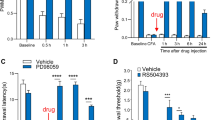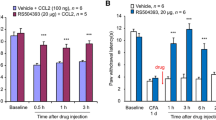Abstract
Functional changes in synaptic transmission from the lateral entorhinal cortex to the dentate gyrus (LEC-DG) are considered responsible for the chronification of pain. However, the underlying alterations in fan cells, which are the predominant neurons in the LEC that project to the DG, remain elusive. Here, we investigated possible mechanisms using a rat model of complete Freund’s adjuvant (CFA)-induced inflammatory pain. We found a substantial increase in hyperpolarization-activated/cyclic nucleotide-gated currents (Ih), which led to the hyperexcitability of LEC fan cells of CFA slices. This phenomenon was attenuated in CFA slices by activating dopamine D2, but not D1, receptors. Chemogenetic activation of the ventral tegmental area -LEC projection had a D2 receptor-dependent analgesic effect. Intra-LEC microinjection of a D2 receptor agonist also suppressed CFA-induced behavioral hypersensitivity, and this effect was attenuated by pre-activation of the Ih. Our findings suggest that down-regulating the excitability of LEC fan cells through activation of the dopamine D2 receptor may be a strategy for treating chronic inflammatory pain.








Similar content being viewed by others
References
Zhang Y, Liu FY, Liao FF, Wan Y, Yi M. Exacerbation of tonic but not phasic pain by entorhinal cortex lesions. Neurosci Lett 2014, 581: 137–142.
Boccella S, Cristiano C, Romano R, Iannotta M, Belardo C, Farina A. Ultra-micronized palmitoylethanolamide rescues the cognitive decline-associated loss of neural plasticity in the neuropathic mouse entorhinal cortex-dentate gyrus pathway. Neurobiol Dis 2019, 121: 106–119.
Bush D, Barry C, Burgess N. What do grid cells contribute to place cell firing? Trends Neurosci 2014, 37: 136–145.
Liu MG, Lu D, Wang Y, Chen XF, Li Z, Xu Y, et al. Counteracting roles of metabotropic glutamate receptor subtypes 1 and 5 in regulation of pain-related spatial and temporal synaptic plasticity in rat entorhinal-hippocampal pathways. Neurosci Lett 2012, 507: 38–42.
Malheiros JM, Guinsburg R, Covolan L. Cortical modulation of pain: Comments on “Exacerbation of tonic but not phasic pain by entorhinal cortex lesions.” Neurosci Lett 2014, 581: 135–136.
Tahvildari B, Alonso A. Morphological and electrophysiological properties of lateral entorhinal cortex layers II and III principal neurons. J Comp Neurol 2005, 491: 123–140.
Notomi T, Shigemoto R. Immunohistochemical localization of Ih channel subunits, HCN1–4, in the rat brain. J Comp Neurol 2004, 471: 241–276.
Gao SH, Wen HZ, Shen LL, Zhao YD, Ruan HZ. Activation of mGluR1 contributes to neuronal hyperexcitability in the rat anterior cingulate cortex via inhibition of HCN channels. Neuropharmacology 2016, 105: 361–377.
Koga K, Descalzi G, Chen T, Ko HG, Lu JS, Li S, et al. Coexistence of two forms of LTP in ACC provides a synaptic mechanism for the interactions between anxiety and chronic pain. Neuron 2015, 86: 1109.
Santello M, Nevian T. Dysfunction of cortical dendritic integration in neuropathic pain reversed by serotoninergic neuromodulation. Neuron 2015, 86: 233–246.
Cordeiro Matos S, Zhang ZZ, Séguéla P. Peripheral neuropathy induces HCN channel dysfunction in pyramidal neurons of the medial prefrontal cortex. J Neurosci 2015, 35: 13244–13256.
Nolan MF, Dudman JT, Dodson PD, Santoro B. HCN1 channels control resting and active integrative properties of stellate cells from layer II of the entorhinal cortex. J Neurosci 2007, 27: 12440–12451.
Fransén E, Alonso AA, Dickson CT, Magistretti J, Hasselmo ME. Ionic mechanisms in the generation of subthreshold oscillations and action potential clustering in entorhinal layer II stellate neurons. Hippocampus 2004, 14: 368–384.
He C, Chen F, Li B, Hu ZA. Neurophysiology of HCN channels: From cellular functions to multiple regulations. Prog Neurobiol 2014, 112: 1–23.
Ozaki S, Narita M, Narita M, Iino M, Sugita J, Matsumura Y, et al. Suppression of the morphine-induced rewarding effect in the rat with neuropathic pain: Implication of the reduction in mu-opioid receptor functions in the ventral tegmental area. J Neurochem 2002, 82: 1192–1198.
Taylor AMW, Murphy NP, Evans CJ, Cahill CM. Correlation between ventral striatal catecholamine content and nociceptive thresholds in neuropathic mice. J Pain 2014, 15: 878–885.
Serafini RA, Pryce KD, Zachariou V. The mesolimbic dopamine system in chronic pain and associated affective comorbidities. Biol Psychiatry 2020, 87: 64–73.
Thompson JM, Neugebauer V. Cortico-limbic pain mechanisms. Neurosci Lett 2019, 702: 15–23.
Baliki MN, Petre B, Torbey S, Herrmann KM, Huang LJ, Schnitzer TJ, et al. Corticostriatal functional connectivity predicts transition to chronic back pain. Nat Neurosci 2012, 15: 1117–1119.
Lee M, Manders TR, Eberle SE, Su C, D’Amour J, Yang RT, et al. Activation of corticostriatal circuitry relieves chronic neuropathic pain. J Neurosci 2015, 35: 5247–5259.
Wang HR, Hu SW, Zhang S, Song Y, Wang XY, Wang L, et al. KCNQ channels in the mesolimbic reward circuit regulate nociception in chronic pain in mice. Neurosci Bull 2021, 37: 597–610.
Glovaci I, Chapman CA. Dopamine induces release of calcium from internal stores in layer II lateral entorhinal cortex fan cells. Cell Calcium 2019, 80: 103–111.
Corder G, Doolen S, Donahue RR, Winter MK, Jutras BL, He Y, et al. Constitutive μ-opioid receptor activity leads to long-term endogenous analgesia and dependence. Science 2013, 341: 1394–1399.
Pan ZQ, Zhu LJ, Li YQ, Hao LY, Yin C, Yang JX, et al. Epigenetic modification of spinal miR-219 expression regulates chronic inflammation pain by targeting CaMKIIγ. J Neurosci 2014, 34: 9476–9483.
Scheff NN, Gold MS. Trafficking of Na+/Ca2+ exchanger to the site of persistent inflammation in nociceptive afferents. J Neurosci 2015, 35: 8423–8432.
de Castro Costa M, de Sutter P, Gybels J, van Hees J. Adjuvant-induced arthritis in rats: A possible animal model of chronic pain. Pain 1981, 10: 173–185.
Marcantoni A, Raymond EF, Carbone E, Marie H. Firing properties of entorhinal cortex neurons and early alterations in an Alzheimer’s disease transgenic model. Pflugers Arch 2014, 466: 1437–1450.
Gao SH, Shen LL, Wen HZ, Zhao YD, Ruan HZ. Inhibition of metabotropic glutamate receptor subtype 1 alters the excitability of the commissural pyramidal neuron in the rat anterior cingulate cortex after chronic constriction injury to the sciatic nerve. Anesthesiology 2017, 127: 515–533.
Simkin D, Hattori S, Ybarra N, Musial TF, Buss EW, Richter H, et al. Aging-related hyperexcitability in CA3 pyramidal neurons is mediated by enhanced A-type K+ channel function and expression. J Neurosci 2015, 35: 13206–13218.
van Aerde KI, Feldmeyer D. Morphological and physiological characterization of pyramidal neuron subtypes in rat medial prefrontal cortex. Cereb Cortex 2015, 25: 788–805.
Ionov ID, Pushinskaya II, Gorev NP, Frenkel DD. Antidepressants upregulate c-Fos expression in the lateral entorhinal cortex and hippocampal dorsal subiculum: Study in rats. Brain Res Bull 2019, 153: 102–108.
Paxinos G, Watson C. The rat brain in stereotaxic coordinates. Academic, New York, 1998.
Gao SH, Shen LL, Wen HZ, Zhao YD, Chen PH, Ruan HZ. The projections from the anterior cingulate cortex to the nucleus accumbens and ventral tegmental area contribute to neuropathic pain-evoked aversion in rats. Neurobiol Dis 2020, 140: 104862.
Hargreaves K, Dubner R, Brown F, Flores C, Joris J. A new and sensitive method for measuring thermal nociception in cutaneous hyperalgesia. Pain 1988, 32: 77–88.
Chaplan SR, Bach FW, Pogrel JW, Chung JM, Yaksh TL. Quantitative assessment of tactile allodynia in the rat paw. J Neurosci Methods 1994, 53: 55–63.
Kimm T, Khaliq ZM, Bean BP. Differential regulation of action potential shape and burst-frequency firing by BK and Kv2 channels in substantia nigra dopaminergic neurons. J Neurosci 2015, 35: 16404–16417.
Missale C, Nash SR, Robinson SW, Jaber M, Caron MG. Dopamine receptors: From structure to function. Physiol Rev 1998, 78: 189–225.
Mishra A, Singh S, Shukla S. Physiological and functional basis of dopamine receptors and their role in neurogenesis: Possible implication for Parkinson’s disease. J Exp Neurosci 2018, 12: 1179069518779829.
Li B, Chen F, Ye JN, Chen XW, Yan J, Li Y, et al. The modulation of orexin A on HCN currents of pyramidal neurons in mouse prelimbic cortex. Cereb Cortex 2010, 20: 1756–1767.
Borsook D, Linnman C, Faria V, Strassman AM, Becerra L, Elman I. Reward deficiency and anti-reward in pain chronification. Neurosci Biobehav Rev 2016, 68: 282–297.
Boccella S, Guida F, Iannotta M, Iannotti FA, Infantino R, Ricciardi F, et al. 2-Pentadecyl-2-oxazoline ameliorates memory impairment and depression-like behaviour in neuropathic mice: Possible role of adrenergic alpha2- and H3 histamine autoreceptors. Mol Brain 2021, 14: 28.
Chung G, Kim CY, Yun YC, Yoon SH, Kim MH, Kim YK, et al. Upregulation of prefrontal metabotropic glutamate receptor 5 mediates neuropathic pain and negative mood symptoms after spinal nerve injury in rats. Sci Rep 2017, 7: 9743.
Brown JT, Chin J, Leiser SC, Pangalos MN, Randall AD. Altered intrinsic neuronal excitability and reduced Na+ currents in a mouse model of Alzheimer’s disease. Neurobiol Aging 2011, 32: 2109.e1-2109.14.
Alonso A, Klink R. Differential electroresponsiveness of stellate and pyramidal-like cells of medial entorhinal cortex layer II. J Neurophysiol 1993, 70: 128–143.
Dickson CT, Magistretti J, Shalinsky MH, Fransén E, Hasselmo ME, Alonso A. Properties and role of Ih in the pacing of subthreshold oscillations in entorhinal cortex layer II neurons. J Neurophysiol 2000, 83: 2562–2579.
Wang X, Lambert NA. Membrane properties of identified lateral and medial perforant pathway projection neurons. Neuroscience 2003, 117: 485–492.
Solomon JS, Nerbonne JM. Two kinetically distinct components of hyperpolarization-activated current in rat superior colliculus-projecting neurons. J Physiol 1993, 469: 291–313.
Yang S, Boudier-Revéret M, Choo YJ, Chang MC. Association between chronic pain and alterations in the mesolimbic dopaminergic system. Brain Sci 2020, 10: 701.
Huang S, Zhang ZZ, Gambeta E, Xu SC, Thomas C, Godfrey N, et al. Dopamine inputs from the ventral tegmental area into the medial prefrontal cortex modulate neuropathic pain-associated behaviors in mice. Cell Rep 2020, 31: 107812.
Glovaci I, Caruana DA, Chapman CA. Dopaminergic enhancement of excitatory synaptic transmission in layer II entorhinal neurons is dependent on D1-like receptor-mediated signaling. Neuroscience 2014, 258: 74–83.
Caruana DA, Sorge RE, Stewart J, Chapman CA. Dopamine has bidirectional effects on synaptic responses to cortical inputs in layer II of the lateral entorhinal cortex. J Neurophysiol 2006, 96: 3006–3015.
Hutter JA, Martel A, Trigiani L, Barrett SG, Chapman CA. Rewarding stimulation of the lateral hypothalamus induces a dopamine-dependent suppression of synaptic responses in the entorhinal cortex. Behav Brain Res 2013, 252: 266–274.
Liu K, Steketee JD. The role of adenylyl cyclase in the medial prefrontal cortex in cocaine-induced behavioral sensitization in rats. Neuropharmacology 2016, 111: 70–77.
Vortherms TA, Nguyen CH, Bastepe M, Jüppner H, Watts VJ. D2 dopamine receptor-induced sensitization of adenylyl cyclase type 1 is Gαs independent. Neuropharmacology 2006, 50: 576–584.
Quintana C, Beaulieu JM. A fresh look at cortical dopamine D2 receptor expressing neurons. Pharmacol Res 2019, 139: 440–445.
He C, Luo FL, Chen XS, Chen F, Li C, Ren SC, et al. Superficial layer-specific histaminergic modulation of medial entorhinal cortex required for spatial learning. Cereb Cortex 2016, 26: 1590–1608.
Acknowledgements
This work was supported by the National Natural Science Foundation of China (81901119 and 81901142), Special Project on Innovation and Generation of Medical Support Capacity, and the Natural Science Foundation of Tibet (XZ2019ZRG-119), China.
Author information
Authors and Affiliations
Corresponding authors
Ethics declarations
Conflict of interest
The authors declare that they have no competing interests.
Additional information
Shi-Hao Gao and Yong Tao contributed equally to this work.
Rights and permissions
About this article
Cite this article
Gao, SH., Tao, Y., Zhu, Y. et al. Activation of Dopamine D2 Receptors Alleviates Neuronal Hyperexcitability in the Lateral Entorhinal Cortex via Inhibition of HCN Current in a Rat Model of Chronic Inflammatory Pain. Neurosci. Bull. 38, 1041–1056 (2022). https://doi.org/10.1007/s12264-022-00892-z
Received:
Accepted:
Published:
Issue Date:
DOI: https://doi.org/10.1007/s12264-022-00892-z




